Grouchy Golf Blog
Saturday, May 03, 2008 at 8:23 PM
Introduced in the Fall of 2000, the Titleist Pro V1/V1x was one of the most revolutionary golf balls of all time by incorporating a multi-layer construction with a soft urethane-covering to virtually eliminate the traditional
trade-offs between distance, spin, feel, and durability. Since then the Pro V1/V1x has been the dominant ball in golf. Dominant among pros and amateurs alike.

Not wanting to be left behind, I adopted the Pro V1 as my primary ball from the get-go. I'm always open to trying the competitor's new offerings, but I just haven't found anything that's materially better yet. Part of the reason is that Titleist isn't content to rest on its laurels. There has been at least 2 major revisions to the original Pro V1/V1x. The newest adds the A.I.M. (Alignment Integrated Marking) sidestamp so that you don't even have to manually
line up your golf ball anymore!
I've always used the Pro V1 rather than its X-rated sibling because I've always thought that the former was softer, spun more and produced a higher ball flight; all qualities that I prefer. According to the Titleist website, here are the differences between the Pro V1 and the Pro V1x:
- Distance: For most players, Pro V1x will be longer off the tee.
- Feel: Pro V1 is softer than the Pro V1x.
- Durability: Pro V1 is the most durable Titleist tour played golf ball.
However, results from the cover story, "
The Best Ball For You" of the February 2008 issue of Golf Magazine seem to contradict some of these claims. According to this exhaustive robot golf ball test,
the Pro V1x is indeed slightly longer than the Pro V1 by about 1.4 yds in total distance (carry plus roll) off a driver (90 mph swing speed, 137 mph ball speed, 13.75-degree launch angle, 2,900 rpm). However, additional tests indicate that the Pro V1x also
spins more (the printed article lists the spin rate of the Pro V1x at vs. the Pro V1 at ) and is
softer! Based on these new test results, here's a revised summary of the differences between the Pro V1 and the Pro V1x:
- Distance: For most players, Pro V1x will be longer off the tee. (According to Titleist and Golf Magazine)
- Feel: Pro V1x is softer than the Pro V1. (According to Golf Magazine)
- Spin: Pro V1x spins more than the Pro V1. (According to Golf Magazine)
- Durability: Pro V1 is the most durable Titleist tour played golf ball. (According to Titleist)
- Ball Flight: Pro V1 has a slightly higher flight. (According to Titleist)
As a longtime Pro V1 user,
I found the new evidence that the Pro V1x is actually softer and spinier than the Pro V1 to be downright shocking. Maybe even more shocking is that it took almost 8 years to come to light. Durability and ball flight be damned, any ball that flies farther and spins more is a better ball in my book. I'll be switching to the Pro V1x right after I go through my current stash of 3 dozen Pro V1s! How about you?
Labels: Equipment
Sunday, April 01, 2007 at 4:08 PM
I recently had the opportunity to chat with Jack Mehoffer, VP of marketing at Hanso Golf, regarding their latest product introduction. It's called "Golden Tees", and they represent the latest in golf tee technology.
Golf Grouch: What are they?
Jack Mehoffer: In short, Golden Tees provide the lowest Static Coefficient of Friction between a golf ball and a tee. In layman's terms, these tees are scientifically proven to provide the least resistance between the golf ball and tee. As a result, the ball will travel farther.
What does this mean for golfers?Research conducted by our Head of R&D, Rod Stiffington, indicates that Golden Tees can increase driving distance 10% or more. So a golfer with an average driving distance of 250 yards can expect a 25 yard increase by simply switching to the Golden Tee.
 How do they work?
How do they work?The wooden golf tee has been used universally since its commercial introduction in the 1920s. Unfortunately, the coefficient of friction from wood is very high, especially against the new urethane-covered golf balls. Metals offer much lower coefficients of friction, but you can't make 100% metal golf tees because they damage clubs and lawn mower blades. Golden Tees offer the benefit of metal contact with the golf ball, but without the drawbacks of 100% metal golf tees. In addition, we are utilizing the metal with the lowest coefficient of friction against urethane, gold."
Are you using real gold?Yes, we only utilize 24K gold. We try to minimize the cost by only coating the contact areas with gold. In addition, we've developed a patent-pending electroplating technology to apply a layer of gold onto the contact area about 100 microns thick. That's about the thickness of a human hair.
What is the availability and retail price?Golden Tees can be found soon at specialty golf retailers for $10 a tee or a package of 50 for $450. We think that this is a small price to pay for a 10% increase in driving distance.
Who's using them?The best players in the world will be teeing up with Golden Tees at this week's Masters. Look for them on TV! Interestingly, Golden Tees are also becoming a favorite among major Hip Hop artists such as Snoop Dogg, Kanye West and P. Diddy. Apparently, they love the "bling".
What's next?Well, we're constantly looking for ways to minimize the friction between the golf ball and tee. We have already developed prototypes of tees utilizing the material with the lowest coefficient of friction. Care to guess what that might be?
I have no idea.It's ice. We are tentatively calling the product "Iced Tee". They are currently undergoing hot weather testing in the Mojave desert. Unfortunately, it appears that there are still some snags that we must overcome before we bring it to market.
Labels: Equipment
Sunday, October 15, 2006 at 11:16 PM
One of the biggest equipment faux pas that golfers make is playing with golf shafts that are too stiff for their swing. Most of this can be directly traced to the golfer's ego.
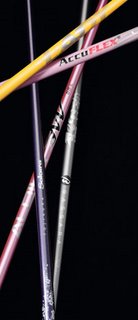
Just like there are no men driving VW Beetles with those dainty flower holders, the macho factor won't allow male golfers to play anything less than a stiff flex.
However, it is important to understand just how shaft flexibility affects performance. After all, the shaft is often known as the "engine" of the golf club.
Theodore P. Jorgensen authored a book called "The Physics of Golf." He conducted several experiments to demonstrate that
the shaft of the golf club during the golf swing actually bends forward at impact. Jorgensen provides a graph indicating that the clubhead lags behind the hands at the start of the downswing. However, by the time that the club is about horizontal to the ground, the clubhead catches up to the hands and eventually leads the shaft at impact.
This is counterintuitive to what most people believe. While all golfers acknowledge that the clubhead lags at the start of the downswing, most assume that it continues to lag until well after impact. Furthermore, it is commonly assumed that the more flexible the shaft, the more that the clubhead lags throughout the swing. Golfers assume these things because that's what it feels like during the swing. However, as with many things in golf,
what you feel is not always what is real.
In reality, the shaft unloads during the downswing and kicks forward by impact, regardless of swing speed or shaft flex rating. Our hands simply cannot outpace the clubhead as the shaft unloads during the golf swing. In fact, the more flexible the shaft, the more that the clubhead will kick forward, increasing velocity and effective loft.
Therefore, all other things being equal, softer shafts provide more distance and a higher trajectory than their stiffer siblings. This applies to all human-generated swing speeds, including that of Tiger Woods.
Tiger himself acknowledges this phenomenon writing, "If I had weaker shafts I'd hit the ball farther just because there's more flex in the shaft and more kick in a regular-flex shaft than in the stiff shafts I use."
So why doesn't Tiger switch to "senior" flex shafts? While a more flexible shaft will provide more distance, the tradeoff is less control. It is simply much more difficult to control the clubface at impact with a more flexible shaft. The last thing that Tiger wants to do is to miss more fairways! For the rest of us, distance is probably our primary concern. Regardless, it is very important for us to play with the right flex for our unique swings. If you haven't done so already, I recommend that you visit your local golf retailer and receive a proper fitting. Finding the correct flex is fast, easy, and usually free.
Labels: Equipment
Sunday, July 09, 2006 at 12:42 AM
I was flipping through the June 2006 issue of Golf Digest recently and came across "The Golf Guru" column. Every month, the Golf Guru answers questions posed by readers of the magazine. It's somewhat entertaining, but the writer tends to write for chucks at the expense of sound advice.
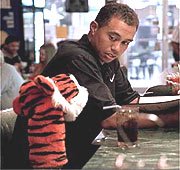
Such was the case in response to a reader's question, "
Do headcovers do any good?"
In short, the Golf Guru believes that headcovers were a remnant of the persimmon wood era that serves no functional purpose today. He argues that headcovers did indeed protect "soft-as-cheese persimmon clubheads and the 'whipping' that bound the hosel to the shaft" but is unnecessary for the modern metal-wood.
However, I think that his advice is a little half-baked for several reasons. For one, some of us like to keep our clubheads free of dings and paint chips. Not only is maintaining the clubhead's condition aesthetically pleasing, but it helps preserve the club's resale value.
But one of the best reasons to use a headcover is to protect those precious graphite shafts. I knew a guy who never used a headcover, whether it was on or off the course. He would just let his clubs clang around in his bag unprotected on the golf cart and also in the trunk of his SUV. Then one day he was hitting driver on the
driving range and the head snapped off. I think the clubhead flew farther than the ball!
You see, not using a headcover leaves the shaft exposed to the leading edges of any neighboring irons. Like eager beavers chipping away at a tree, the countless mini-dings from these irons can weaken the shaft to the point where it may break. At least that's what the pro shop guy says. Whether it's true or not, why take the chance?
Lastly, a headcover can protect your club from the prying eyes of thieves. With clubs such as the
TaylorMade R7 TP worth as much as some people's cars, a
generic headcover is the best deterrent for the growing
golf club theft problem.
As you can see, there are some good reasons to continue using headcovers. But please, for the love of mankind, don't use a tiger headcover unless your name happens to be "Tiger." Otherwise, it's rather poseur-ish.
Labels: Equipment
Sunday, June 04, 2006 at 10:42 AM
When I first started playing golf, there were no grass driving ranges in my area. By default, I was forced to practice on artificial grass range mats.

Not knowing any better, I believed that they were just as good as the real thing. Boy was I wrong. Indeed, I became pretty proficient hitting golf balls off padded Astro Turf. But that's a lot like saying you can fly a plane well after only piloting a video flight simulator.
While hitting a teed ball off range mats doesn't pose a problem, hitting unteed balls off range mats can adversely affect your swing.
The main problem with range mats is that they don't allow you to take divots. When an iron impacts real grass, it digs in and scoops out a chunk of turf leaving the so-called divot. When this happens in relation to contact with the golf ball is all the difference with iron ball-striking. When hit properly, the iron contacts the ball
before it impacts with the turf.

If the iron hits the turf before the ball, the turf will interfere with the iron on ball contact resulting in the so-called "fat" shot (see picture). Besides the dreaded
shank, the fat shot is the ugliest shot in golf.
Laying sod is for landscaping your yard, not for hitting a golf ball.
Practicing on real turf gives you the necessary feedback to learn
proper iron ball-striking. Hit a fat shot on real turf, and the ball behaves just like it does on the golf course - it goes nowhere. The beauty is knowing that you must have done something incorrectly to produce such a poor result. However, a fat shot on a range mat will likely produce a somewhat acceptable result. How do you improve if you don't know when you are doing something wrong?
Another problem with range mats is that they are unyielding to the impact from a properly struck iron. As a result, golfers may try to minimize contact with the mat, adversely affecting their swing. I certainly felt that extensive practice on range mats caused me to develop an overly shallow swing and become a "picker" of the golf ball. In other words, I was hitting the golf ball without taking a divot whatsoever.
While I don't think that there's anything significantly wrong with being a "picker", the margin for error is much less for a picker. Strike the ball one or two
grooves lower than normal on the clubface, and a picker will hit it thin. A steeper swing will forgive such faults.
Lastly, the firmness of mats may actually start to alter your clubs! If you have soft, forged irons, the constant pounding against a range mat could bend the club's lie angle. Be sure to have the lie angles of your forged irons checked if you've been hitting off a mat.
Thankfully my local course now has a full-time 100% real grass driving range. I realize that my extensive practice on range mats was not only largely fruitless, but also detrimental. I now refuse to practice on range mats, using them only to warm-up before a round in the absence of a grass range. As Cheech and Chong might say, "there's just no substitute for real grass."
Labels: Equipment, Swing Tips
Saturday, May 06, 2006 at 9:23 PM
The UPS delivery guy is the Santa Claus for adults. I always get that sudden rush of excitement when I see that plain brown cardboard box sitting on my doorstep. Such was the feeling when I recently found a long, skinny box perched against my front door. Inside was an Alpha C830.2 driver with an Aldila NVS shaft!
You may be wondering,
what the heck is an Alpha C830.2? We are all familiar with the big golf club companies such as Titleist, Ping, TaylorMade, etc. These guys have huge marketing budgets to ensure that they remain top of mind with the consumer. As a result, it's very difficult for the new and smaller golf companies to get noticed.
Alpha Golf is one such golf company. Started in 2000, Alpha was able to attract some attention relatively quickly by making a name for themselves in the sport of professional long drive. Long drive is golf's loud, rebellious and juiced-up younger brother. It is a sport that takes one element of golf to the max and then kicks it up a notch. To be successful, competitors need equipment that can withstand extreme conditions.
Alpha Golf recognized this need and developed drivers that could take the punishment while still offering top performance. Alpha's success on the Long Drivers of America (LDA) circuit speaks for itself. But how would such a specialized driver work for the average golfer?
That's what I wanted to find out with Alpha's C830.2. I had read that the driver head was a full 460cc, so when I opened the package I fully expected to see a Yugo on a stick.
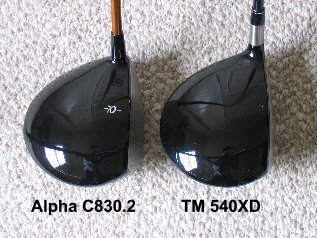
However, I was surprised to find a rather conventional looking driver in terms of size. In fact, it looks even smaller than my 400cc TaylorMade 540XD when viewed from the top! At first I thought that I had received the wrong driver, but "460cc" was clearly stamped into the sole.
Like Anna Nicole Smith, the Alpha C830.2 hides its mass well.
I was anxious to get to the course to see how the Alpha C830.2 would stack up. To be honest, I haven't hit many 460cc drivers. They always appeared a little too big for my liking. In this respect, the C830.2 was easy on my eyes.
I have been playing with the C830.2 exclusively over the last month and I can honestly say that I'm pleasantly surprised.
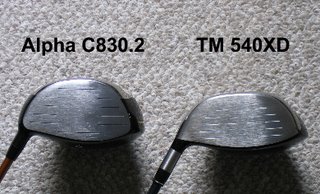
With my trusty ol' TaylorMade 540XD, I probably drive the ball an average of 260-270 yards when I nut it. It's hard to say for sure, but it seems that I'm a little longer with the C830.2. I just don't know if it's the sword or the swordsman. I could be subconsciously swinging harder than normal because I know that the C830.2 is a "long drive" driver. Regardless, I've hit some of my longest drives ever on my home course with the C830.2.
In terms of accuracy, the C830.2 fares well. With 460cc, it better! With all that surface area from its deep face, I seem to hit the screws on the C830.2 more frequently than my 540XD. As a result, my drives are a little bit more accurate.
As far as feel goes, I would characterize the C830.2 as having a solid metallic feel and sound, reminiscent of a Titleist driver. It doesn't have that hollow aluminum baseball bat sound found on some of the other 460cc drivers.
Having put the C830.2 through its paces, I believe that it compares very favorably against the "Big Name" offerings. Whether it is the right driver for you is another question.
I feel that golfers need to demo many different drivers to find one that best fits their individual game. That being said, the C830.2 is definitely worth a swing. It may be especially attractive to those traditionalists who are uncomfortable looking down at some of the gigantic looking 460cc drivers out there. Just don't fall into the trap of assuming that the C830.2 is a "long drivers only" club. It works great for the "average" player as well.
Labels: Equipment
Sunday, April 30, 2006 at 11:42 AM
Now that the
RadarGolf system has made it to retail, I wonder just how successful it will become. The company has certainly been successful garnering media attention and forging alliances with major retail partners such as Golfsmith and The Sharper Image. However, the product itself still seems a bit too gimmicky because it only finds its own proprietary golf balls. Once the novelty wears, will it have a viable market? I remain dubious. Golfers just won't give up their Titleist Pro V1s!
Well, there is another golf ball finding system called the
BallFinder Scout that finds
all (white-colored) golf balls, not just special ones.

Remember those cool fictional robots from the movies,
The Terminator and
Robocop? They possessed advanced optical recognition technology to scan an area and highlight objects of interest. This is kinda how the BallFinder Scout works. The system utilizes digital video camera and color recognition technology to identify white golf balls.
According to the website, the device:
- is similar in size and weight to a mobile phone
- utilizes a 3.2 mega-pixel imager to locate balls within a range of up to 35-feet
- searches up to 600 square feet in one second
- can locate balls with just 3 dimples on the ball visible
But how do you use it? According to the website:
Just point the SCOUT™ in the direction where you think the golf ball may be hidden press the button and slowly move the SCOUT™ in a side to side scanning motion, once the SCOUT™ "locks" onto a ball you will see small red brackets appear on the LCD screen highlighting the area where a golf ball is located, the golfer then walks towards the area shown on the LCD screen to pick up the ball - its that simple!
Aside from the grammatical landmines, it sounds great. But like most things, I'm a bit skeptical. While it is endorsed by the great
Han Faldo, I'm curious about the real world effectiveness of this device in practice. Even if it works as advertised, is it a solution to a problem that needs solving? Sure, it'd be nice to have a device that finds lost golf balls, but at what price? According to the website, you can order a BallFinder Scout for £148.00. At the current exchange rate of $1.8259 per £, that amounts to a tad over $270. Assuming that a slightly used Pro V1 is worth about $2, it would take about 135 found Pro V1s to recover your investment! I don't know about you, but I can't imagine that I'll lose that many balls in my lifetime. Regardless, I'm a gadget freak, so I may just have to procure one of these babies! Maybe I can hack it to find other stuff like lost money...
Labels: Equipment
Sunday, March 19, 2006 at 11:23 AM
The more greens that you can hit, the better. However, balls landing on the green often leave marks that damage the green's root system. If these ball marks are not fixed, the affected turf turns brown and dies, takes weeks to regenerate, and infuriates your greenskeeper.
I make it a habit to fix as many ball marks that I find when I'm on the green. I really appreciate it when others do the same. However, I can't tell you how many times I see golfers fix ball marks incorrectly.
More times than not, I'll see a well-intentioned golfer plunge his ballmark repair tool behind the ball mark and then pry it upward like he's trying to uproot a weed. I cringe because I know that such action only worsens the damage done to the green, prolonging the healing process. If done correctly, fixing a ball mark will start the healing process immediately, rather than weeks later.
Here's the correct way to fix a ball mark:
- Use a ballmark repair tool to do the job most efficiently.
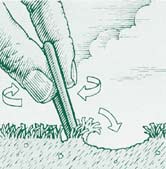
- Insert the repair tool at the edge of the high side of the ball mark.
- Push the tool forward from the edge of the ball mark toward the center. Do this around the edges of the indentation.
- Do NOT insert the tool under the indented area and push up - a common mistake. Think of it as pushing turf in from the edges toward the center.
- Tap down the repaired area.
Here are some good links demonstrating proper ball mark repair technique:
Green-SaveFinkbine Golf CoursePlant Management NetworkGCSAATogether, we can make golf a little less grouchy.
Labels: Equipment
Sunday, March 12, 2006 at 6:52 PM
Last summer, I played a round at Angeles National with Rich from
Eatgolf.com. We were paired with an older man and his son. Mid-way through the round, the son started to offer Rich some equipment advice. He believed that Rich's drives were too low and he recommended that Rich play with a driver with more grooves to impart more backspin. Upon hearing this, I just grimaced. I had recently read about the topic of grooves on the Internet and I knew that his advice was flawed. As a person who hates to hear bad advice, I felt the need to interrupt. I remarked, "Actually, I've read that grooves on a driver clubface don't add a lick of spin.
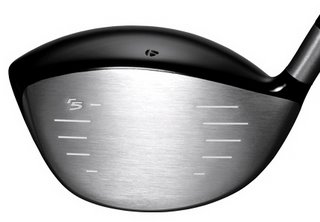
Just look at the new TaylorMade drivers. They don't even have grooves in the contact area." Everyone just looked at me dumbfounded.
According
to equipment guru Frank Thomas, "...the grooves on a driver do nothing with regard to ball spin." In fact, some studies have shown that grooves on a driver can actually decrease spin.
Pat Ryan Golf wrote about the findings of Art Chou of Chou Golf Design Labs and Deshou Liang of Drexel University. They discovered that a smooth faced club at low loft angles (less than 20 degrees) produces more backspin than a rough surface.
So grooves on drivers don't add spin. But how about other clubs? Surely, grooves make a difference, right? Yes, just not in the way that most people think.
According to Paul Smith:
The backspin is created by the balls compression on the clubface. This occurs between the time of impact and the moment of separation from the clubface. The clubs swing path and type of head rotation sees the ball mashed into the clubface. The loft presented to the ball distorts it in shape and gives us the launch angle and all of its backspin. The ball does not actually ever ride up the clubface, instead it gets imbedded in the face where the groove lines reside. High-speed photography has proved this. The more loft the greater the backspin.
Therefore, the grooves have zero influence on the launch angle or backspin on the ball. Well known club designer Ralph Maltby built a set of irons with no face groves at all and played with them extensively to prove this point to disbelievers.
Also, in the mid 1980's the USGA undertook extensive groove type testing and concluded that in dry conditions it was loft, not grooves that put backspin on the ball.
So what good are grooves then? Rather like car tyres which work perfectly in the dry, we need them to work in the wet as well. Clubfaces without grooves work fine in dry conditions but with water and grass in the way, the grooves allow some of the trapped materials to be moved from the collision zone. Without groves you may get a high flyer with less spin and in this instance the ball does in fact run up the face - it actually skids up the face on the lubricating water and/or grass.
The Sand Trap offers a similar explanation saying, "The main purpose of grooves is to collect dirt, grass, and water, thus increasing ball/steel contact." So if grooves aren't the primary producers of spin, then how do those pros on TV hit those high-spinning shots?
Frank Thomas explains, "pros produce high spinning shots by striking the ball cleanly with a descending blow on an oblique angle..." In other words, perfect ball-striking.
Labels: Equipment
Sunday, March 05, 2006 at 12:23 PM
Snake-oil salesmen have long found golf to be fertile ground to hawk their wares. I can't think of another sport that has as many gadgets and gizmos that don't do squat. Thankfully, most are obviously junk upon first glance. However, there are some things that make you wonder if it's legit.
One such gadget that has always piqued my interest is the Technasonic Check-Go. It has been around since the late 80s and it is still a hot seller. In a nutshell, it's a device that's supposed to find the optimal balance point (equator) of a golf ball by spinning the ball at high speeds.

Why is this important? Well, if you putt the ball along its balanced equator, it should roll truer on the green. Dave Pelz, the mad scientist of golf, has done research in this area and wrote, "Physics is physics. If balls are not balanced and they are not lined up on their balance point, they’re not going to roll straight."
It sounded good enough for me. I plunked down around 30 hard-earned greenbacks to satisfy my curiosity. Once I opened the package, I inserted my AA Duracells and got "Check-Go-ing" on a new box of Pro V1s. It seemed easy enough; just place the golf ball on the holder, attach the cage, hold down the button to spin the ball, and then mark the ball with a pen. Well, it actually takes some practice.
On my first attempt, the Pro V1 spun wildly out of control when I tried to mark it with the pen. Instead of a straight line along the ball's balanced equator, I ended up with a ball half-covered in ink! But after a couple more attempts, I started to get the hang of it.
The key is to let the ball spin up to the maximum speed and then apply the pen to the ball lightly with increasing pressure. To get a heavier line, go back over the Check-Go line with a Sharpie and the
Gatorade Line-M-Up method.
For the most part, the Check-Go works as advertised. I have put dozens of balls through this thing and it has always found the ball's balance point. Whenever I re-spun a marked ball, it would return to the same balance point indicated by the original line.
The only gripe that I have with the Check-Go is that the line that is manually drawn is frequently "off" a bit. The cause of this problem is the way that the pen is aligned and applied to the ball. To draw the line on the ball, the pen is simply inserted into a hole of the cage. Unfortunately, this hole allows some "play" with the pen allowing the pen approach the ball at varying angles. As a result, the line can be off from the true center of the ball. I have a couple of Pro V1s with off-center lines and I find it very distracting when I putt. Technasonic could improve the Check-Go immensely and probably sell a lot more of them if they just devised a way to apply the pen to the ball more accurately.
While I'm confident that the Check-Go does find the balance point of a golf ball, I'm not sure that it really matters in practice. I haven't noticed any difference to my putting results. I'm probably just not good enough to know. But if you believe that balanced golf balls will make a difference to your game, then the Check-Go is a great product for you.
Labels: Equipment
Thursday, January 26, 2006 at 10:15 PM

Grouchy Golf welcomes your grouchy golf observations. If you have a grouchy golf observation that you would like to be posted on Grouchy Golf, please email it to the address in the sidebar. Remember, all submissions become the property of Grouchy Golf. Submissions chosen for publication may be edited for length and clarity.
The following story was submitted by a grouchy golfer named Tom. Tom's tale involves a do-it-yourself golf club customization to one of the hottest drivers on tour, the TaylorMade R7 Tour Preferred (TP). Yes, it is possible to make this driver
even hotter. Thanks Tom!
One Sizzling R7 Driver!Ok, so here's something you don't see every day. My friend (his identity shall remain a secret, as I have promised him that) owns a TaylorMade R7 TP retail driver. While he likes the driver overall, he strongly disliked the tinny sound it made at impact.
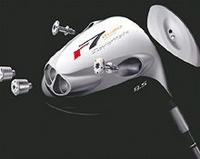
He decided to stuff cotton into the weight holes to try and deaden the sound. But after doing so, the cotton compacted, and he ended up with about 20 little pea-sized cotton chunks rolling around in his clubhead. It sounded like peanuts in a jar!
What he did next is the interesting part. He deduced that, since there was no way to retrieve the cotton pellets and cotton was flammable, it would be clever to pour a little gasoline into the weight holes and let the cotton soak it up. Then, he could light it and burn the cotton into noiseless ash. Here is where the trouble starts...
I think he poured a little too much gas into the holes because when he lit it, flames shot out about 6 inches from all four holes, scaring the living $hit out of him! He dropped the club immediately and it landed head first onto the driveway (at least he was smart enough to do this highly technical procedure outside), leaving big scrapes on the crown. When he thought that the fire was out, he picked up the driver by the head only to feel the sharp pain of hot metal searing his fingertips. In knee-jerk reaction, he dropped the club again, scratching up more of the clubhead!
After a momentary fit of rage, he collected himself and tried to think through the situation. He decided to play it smart and allow the club to cool off before he picked up the club. Staring at his nicked up baby, he wondered if he could buff out the scratches in the paint. Well, those concerns about scratches soon became irrelevant as the paint started peeling off the clubhead before his very eyes! It turns out that there was still a bit of fuel inside the clubhead that continued to burn as my friend waited for it to cool. The smoldering fuel heated the clubhead so much that it peeled off most of the paint!
But there is a bright side to all of this - the procedure to burn away the cotton worked, and there are now NO more rattles in the head!!! When he phoned me and told me this story, I just about peed myself laughing, which prompted him to hang up the phone on me. I will try to be more consoling in the future...
Golf Grouch Comment: That's one way to smoke your driver! Who knows, maybe an engineer at TaylorMade will read this story and turn it into the next big thing in driver technology: RPD (Rocket Propelled Driver). Tom, tell your friend that he'd better apply for a patent pronto!
Labels: Equipment, Viewer Mail
Friday, December 16, 2005 at 11:42 PM
It's the holiday season, and gift giving will soon be in full force. IMHO, finding a gift for a golfer is a relatively easy task. I can't think of another sport that has spawned such a wide array of products at virtually every price point. As a result, it's easy to find a golf gift for every budget. But what if you were Donald Trump? What regoddamndiculously expensive gift would you buy for that special golfer in your life?
Believe it or not,
there are putters out there with asking prices that eclipse that of a nicely-equipped brand-spankin' new 5-Series BMW.
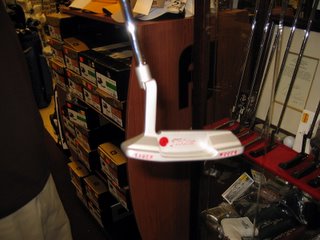
The owner of a local golf shop here in Los Angeles is supposedly a close personal friend of Scotty Cameron, so he has a lot of "one-of-a-kind" and signed Cameron items for sale. I was at this store recently and snapped some photos of the most highly prized item, a backup to Tiger Woods' Scotty Cameron putter!
The people at this golf shop are some of the friendliest and most knowledgeable in the business. They told me that Scotty crafts only a handful of custom putters with the exact specs for the great Tiger Woods. They even have a hand-written and signed letter from Mr. Cameron himself as confirmation.

Be sure to click on the photo to zoom in and read the words written by the God of Putters himself!
The putter in this picture is an exact copy of the Newport 2 303 GSS Cameron gamer that has resided in Tiger's bag since the
1999 GTE Byron Nelson Classic. Notice the single large red dot or "cherry bomb" on each side of the putter. This is a standard Cameron practice to denote a Tour putter. It appears that there are only 4 of this exact model year in existence. It's truly a beautiful and rare piece of golf equipment.
But is this special putter really worth a luxury mid-size German sedan? I was told that a customer did pony up that kind of cash for a previous Tiger model. Remember, something is only worth what someone is willing to pay for it.
Keep in mind that this isn't even a putter that Tiger has played. It's not even the backup to the putter that he plays. It's really the backup to
the backup. You can only imagine the value of Tiger's gamer. Are we talking six or even seven figures?
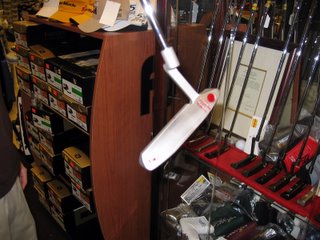
But this is just one of the 14 clubs that fill Tiger's bag. Steve Williams must be carrying sticks worth many times more than their weight in gold. I wouldn't be surprised to hear that Stevie lugs around a bag worth more than several million dollars on his back. I just hope he read about my post about
golf club thefts.
To anyone who may be considering giving me a Tiger Woods' club as a gift this holiday: I think that I'd rather have a bimmer...
But if you are seriously interested in buying a rare Cameron putter,
make sure that it has been authenticated. Obtain the registry number and enter it at the
Scotty Cameron Registry to verify its authentication! If you have any more Cameron-related questions, just ask my friends over at
The Cameron Collector. They are the real experts!
Labels: Equipment, Scotty Cameron, Tiger Woods
Thursday, November 17, 2005 at 12:04 AM
If you had a suitcase stuffed with over $2,000 cash, would you ever leave it outside and unattended? Well, that's what happens all the time at golf courses around the world. Obviously, it's not cash, but it's something just as valuable: golf clubs.
Consider someone who carries the latest Callaway Golf clubs purchased at
Golfsmith.com:
- X Tour 3-PW Iron Set w/ Steel Shaft: $899.99
- Big Bertha Fusion FT-3 Neutral Driver: $359.99
- Big Bertha Fusion Fairway 3 Wood: $299.99
- Big Bertha Fusion Fairway 5 Wood: $269.99
- Forged + Wedges - Chrome 56: $ 99.99
- Forged + Wedges - Chrome 60: $99.99
- White Steel 2 Ball Blade Putter: $169.99
- Hybrid 45 Stand Bag $169.99
Such a bag sits on the high-end of the price spectrum, but I see similar bags unattended at my home golf course all the time. For some reason, there's sort of a mutual feeling of trust amongst golfers at golf courses. It's like we're all soldiers waging war against a common enemy: the golf course. No golfer would dare steal the weapons of their brothers in arms.
Unfortunately, there are unsavory characters out there who exploit this camaraderie for personal gain.

Golf club theft is nothing new, but the problem is now more common than ever before. One of the reasons is the rise in club prices due to high tech designs and exotic materials. But the main reason is the emergence of my favorite online marketplace,
eBay.
With eBay, criminals can sell "hot" clubs at premium prices in a couple of clicks.
But the problem recently gained national attention when USA Today reported that
thieves stole the golf clubs of police officers! Interestingly, the incident occurred last May at a police department golf tournament held at Santa Anita Golf Club, one of my local golf courses! The USA Today article also mentioned a robbery at my home course, Brookside golf course.
I know the guys who work in the Brookside pro shop, so I asked them about the article. They confirmed that club theft has always been a problem and that eBay has made it worse. However, they said that since USA Today ran the article, they haven't had a single incident.
I was relieved since
I had no idea that I lived in the golf club theft capital of the world (or at least it seemed that way when I read the article). Luckily, I have never been the victim of theft.
Here are some tips that I follow to remain theft-free:
- Never leave your golf bag unattended, especially outside. If you have to go inside, take your bag with you. Many on-course pro shops and restaurants allow you to bring your bag inside.
- A common scam is the old driver switcheroo. The perpetrator simply takes an old and worthless driver and covers the clubhead with the headcover from the latest "hot" driver. He'll then hang around a golf course looking for an unattended bag containing the "hot" driver sheathed in an identical headcover. When no one is looking, he swaps the "fake" driver for the real one in a matter of seconds. The victim usually doesn't know that he's been swindled until he gets to the first tee. To prevent this, simply ditch the fancy headcovers that came with your clubs and replace them with either generic or low-end headcovers.
Labels: Equipment
Wednesday, October 26, 2005 at 1:42 AM
As a person with a business background, I love to think of business ideas. However, my ideas can sometimes be considered beyond "out of the box." One such idea was hatched a couple of years ago after I became so frustrated over losing about a dozen Pro V1s at
Lost Canyons (the most appropriate name for a golf course ever).
My idea was to irradiate golf balls with a low-level radioactive isotope. Golfers who lost such balls could simply use a Geiger counter to find their balls. It sounded great at first, but then I realized that there could be litigation risks associated with potential health hazards to golfers who carried radioactive balls in their pocket. Would it really be so bad to grow another arm? Who knows, it could improve your swing.
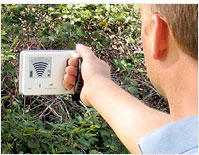
Anyway, a company has already developed a similar concept, without the radiation risks.
RadarGolf has developed a microchip that is designed to be embedded into a golf ball. The chip is designed to communicate with a handheld device carried by the golfer. When the golfer loses his ball, he simply activates the handheld to transmit a specific radio frequency signal. Like a Spidey tracer, the chip receives the signal and sends back its own signal, causing the handheld to beep faster and at a higher pitch as it gets closer to the ball.
I think that this product has some potential for success. However, one glaring shortcoming that I see is the fact that
the system only works specifically with RadarGolf Balls. There's just no way that you're going to pry golfers away from their precious Pro V1s to play some findable ball that most wouldn't want to find in the first place. Therefore, I recommend that RadarGolf pursue a strategy to get their product in established golf ball brands. I'm sure that Titleist would be interested to incorporate the RadarGolf chip into their golf balls as a premium feature or product extension. For example, they could retail a dozen regular Pro V1s at $50 and RadarGolf Pro V1s at $60. I think that such a product offering could be attractive to certain golfers. This all sounds great in theory, but we'll have to see how it works in practice.
The RadarGolf System (the handheld unit with a dozen balls) was scheduled to be introduced sometime this month on the Web for $349.95. However, the last time I checked, there was no purchasing info. Maybe they're rethinking their business model. I think that would be a good idea.
Labels: Equipment
Wednesday, September 14, 2005 at 11:00 AM
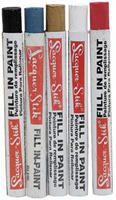
If you've played golf long enough, your clubs will inevitably show signs of wear. Paint chipping off of golf clubs, especially forged irons, is one of the most common signs of wear. However, it is also one of the easiest problems to fix.
Recently, I wanted to fix some of my paint-chipped Mizuno MP-14 irons. But I wanted to do it the correct way. So I emailed Mizuno and asked them for advice in this matter. They promptly replied that I should try something called, "Laquer-Stik Fill-In Paint" by
LA-CO Industries, Inc.After some creative Googling on the Internet, I found that Laquer-Stiks are sold by
The GolfWorks. They seem reasonably priced at just under 3 bucks apiece and come in colors commonly found on golf clubs.
According to GolfWorks.com, "Using any sharpened instrument like a dental pick or nail, carefully etch the engravings or stampings, removing most of the original paint. Next, rub the appropriate color of Lacquer-Stik (See Pg. 6-4 of our Full Line Catalog for the complete listing of colors) into the letter or number cavity. Wipe away the excess color and the results will amaze you -- it looks great!"
The nice folks at
Rite-Mark Stamp Company offered to send me some Lacquer-Stik samples to try. I received a black Lacquer-Stik to try on my Mizuno MP-14 irons. Below is a before and after pic of the sole of my 6-iron that was completely devoid of paint.

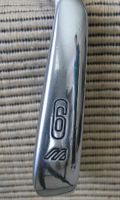
While the product was very easy to apply,
it doesn't cure to a rock-hard finish like paint. Instead, it stays somewhat flexible and malleable. While this is great for certain applications, it's not ideal for something that strikes the ground repeatedly at around 80 mph.
I've been playing with the Lacquer-Stik filled clubs and they seem to be holding up. However, I doubt that they will last very long. If they don't, I'll try another recommendation that was given to me by a clubfitter: Testors model paint applied with a toothpick. Right now, that sounds like the best solution. I've also heard that nail polish works well, but won't be seeing me buying anything at any MAC store.
P.S. I'll try to keep the "Golf Deals" section in the sidebar current. Be sure to check out the free Pinnacle golf balls offer. You can't beat free! Let me know if the offer has expired so that I can remove the link. I think it will go pretty quick.
Labels: Equipment
Wednesday, July 06, 2005 at 8:46 AM
When I first started playing golf with my good friend and scratch golfer
Anth, I noticed that he occasionally licked his golf ball before he set it down to putt. After shooting him several puzzled looks without a response, I asked him, "What the hell are you doing?"
"I'm cleaning my ball so it will roll true," he answered.
"I know that, but do you have to use your tongue? Why don't you use a towel?"
"I don't have one with me. What's the big deal?"
"It's just disgusting. There could be all kinds of crap on that ball. Why don't you just lick the ground?"

He just rolled his eyes and shook his head
as if I was the one being ridiculous. On the next green, he licked his ball again like he was working his way to the Tootsie Roll center. I didn't say anything about it to him again. I mean, who am I to question a scratch golfer?
I have since played with several golfers who lick their balls clean. Recently, I tracked down a course maintenance person and told him about this phenomenon. He informed me that there are indeed many toxic substances on a golf course that could cling to a golf ball.
Fertilizer, weed killers, pesticides, and animal guano are just some of the awful things one may ingest from a soiled golf ball. He confirmed that it was not a good idea to lick your balls clean. In fact, he thought it was downright dangerous. Apparently, it's quite
a common practice in Ireland.
So please, let this be a warning to you or someone you know who may suffer from this nasty habit.
Labels: Equipment
Wednesday, June 01, 2005 at 11:04 AM
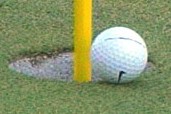
You may have noticed that some golfers draw a straight line on their golf balls to help them line up the ball to putt. It's even a common practice on the professional golf tours. If you saw Tiger Woods' miraculous chip shot at the 16th hole of the 2005 Masters on TV, you got a good close-up of his lined Nike One Platinum ball as it hung momentarily on the lip of the cup.
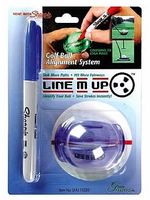
The most common device to draw such a line on a golf ball is a product called the "
Line-M-up." It's essentially a piece of plastic that you snap on a golf ball. It has a slot where you can draw a straight line on the golf ball with a permanent marker such as a Sharpie pen.
You can buy the Line-M-up at most golf stores.
At Golfsmith, it costs $8.99. Yes, $8.99!
While that may not sound like much to some, it's quite a lot for something that looks like it cost about 5 cents to manufacture. Sure, it comes with a Sharpie, but what does that cost, another 20 cents? Assuming a standard 100% retail markup, I estimate that the Line-M-up wholesales for about $4.50. To be generous, I'll assume that the Line-M-up costs a total of $.50 to manufacture and package. That means for each Line-M-up sold, the manufacturer makes $4.00 in profit, or a 800% profit margin!

I'm not against anyone making a buck, but to me this is grossly excessive. As a businessperson,
I refuse to buy this thing based on business principle alone. But that doesn't mean I don't draw a line on my ball. For the price of a bottle of Gatorade, I have a ball line-drawing device.
When I wrote, "a bottle of Gatorade" I literally meant
a bottle of Gatorade. I just use the plastic safety ring that detaches from the cap of a 20 oz. bottle of Gatorade as a straight-edge for golf balls. Amazingly, it fits on a golf ball almost perfectly! Not only do you have something to line your golf balls, but you also have a tasty beverage to wash down that crusty old hot dog that you bought at the turn. To ensure a straight and balanced line, use the
Technasonic Check-Go to pre-draw the line. Just take a look at these pics to see how easy it is to "Line-M-up" ghetto style:



Labels: Equipment
Tuesday, April 26, 2005 at 9:48 AM
Golf training aids are a dime a dozen. No other sport has spawned such an array of gizmos designed to teach people how to play a sport. There are weighted clubs, hinged clubs, molded grips, alignment aids, impact bags, positive energy bracelets, laser-guidance systems, you name it.
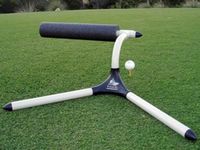 But I hear that the one golf aid that delivers real results is the Inside Approach
But I hear that the one golf aid that delivers real results is the Inside Approach. Heck, it's even endorsed by the greatest golfer of all-time, Jack Nicklaus himself.
It's designed to fix the common "over the top" movement that produces that ugly slice generated by the vast majority of golfers. While it may be "holy grail" for banana ballers, the only thing I could think about as I was watching the Inside Approach infomercial was
damn that looks cheap. And when I say "cheap", I mean cheap in construction and cheap to make. It literally looks like it was pieced together by some 6 year-old kid let loose in the plumbing department at Home Depot. I was totally floored when the price appeared on my TV:
$79.99! Are they serious?
I know the dollar doesn't go as far as it used to, but no person with at least half of a brain can look at this thing and say, "yeah, that looks like it's worth 80 bucks." Naturally, knock-offs such as the $24.95 "
Slice Buster" sprouted immediately to capitalize. But is such a device even worth that much? Even if it cures your slice for good?
I say,
"Hell no." I figure that I could make it myself out of PVC pipe for about the price of 2 Big Macs. But lo and behold, the guys over at
Free Golf Info Forums beat me to it. Check out the "
Do-It-Yourself Inside Approach" (you need to be logged in to view). They have detailed plans, instructions and photos for anyone to build their own version of the Inside Approach. Sorry Jack.
Labels: Equipment
Tuesday, March 15, 2005 at 10:54 AM
One thing that I've noticed recently when I play golf is the number of 20-handicappers who'll say something along the lines of "this new ball that I'm using is adding at least 10 yards to my drives." I usually feign interest and say something patronizing like, "Wow, that's technology these days." They don't know it, but I'm rolling my eyes behind that enthusiastic veneer.
I blame the media. It's almost impossible to watch golf these days and
not hear how the ball travels so much further than before. Some old-timers are even crying that the new balls are ruining the game.

One bitter old fart who's been harping on this topic is the former PGA Tour commissioner, Deane Beman. In a recent interview, Beman said, "I have a great deal of respect for the players today and what they can do. But many of them are being cheated out of really learning how to perfect their craft because of the technology they're playing with.
If you put the old ball in front of them to play, it would be a massacre."
It sounds to me like he's yearning for the "good old days." People like this can't accept that today's golfers, and athletes in general, are much better as a whole than those in yesteryear.
I'm not saying that technology isn't a factor. I do think that the golf ball is eons better than before. However,
I think that some of the things that the media is saying is misleading for the amateur golfer.When the media says that the ball is longer than before, they mean
specifically the ball that the pros use. As Paul Azinger acknowledged in a recent ABC telecast, the ball
isn't necessarily traveling any farther now than before. For example, a Pinnacle distance ball from 5 years ago goes just as far, if not
farther, as the latest Pro V1. The real difference is that the pros would never use a Pinnacle because it lacked
spin.
There used to be a major tradeoff in ball performance between spin and distance. Since spin control is much more important to a pro than distance, high-spin wound balata balls were the norm on tour back in the day. While these balls felt like you were hitting a marshmallow, it went about as far as one too. If you wanted distance, you had to sacrifice spin and play with a two-piece solid core "rock."

However, with today's multilayer technology, ball manufacturers are able to produce balls that feel and spin like a wound balata, but travel the distance of a solid core ball. Therefore, the pros are able to achieve more distance without compromising spin control. On the other hand, most amateurs are accustomed to solid core distance balls. So when amateurs transition to the modern multilayer ball, they
aren't gaining more distance. Rather, they're getting more
spin control.
Unfortunately, it takes too much effort for me to explain all of this to every 20-handicapper who tells me that his ball is giving him "10 more yards." And who the heck am I to rain on anyone's parade?
P.S. Peter Kostis wrote an article on this very topic, "
Stop Blaming the Ball!"
Labels: Equipment
Tuesday, March 01, 2005 at 11:09 AM
When Dean Kamen first introduced the Segway Human Transporter in December 2001, he revealed one of the most hyped inventions of all-time. Corporate luminaries who'd gotten sneak previews described the machine's impact as being "as big as the PC" and "bigger than the internet." Kamen himself boasted that his creation "will be to the car what the car was to the horse and buggy." He even believed that the Segway had the potential to alter society. He claimed, "If the Segway HT is widely adopted, it could help solve major urban problems, such as pollution, congestion and livability."
With these kind of claims, I was expecting a futuristic 'Jetson's-style' anti-gravity device. What a letdown when I found out that the Segway was just an overpriced electric scooter. Yeah it was cool. But at about $4,000, I can think of much cooler things to buy. I guess most people felt the same since
a Segway sighting today is about as common as a Bin Laden sighting.
It appears that Mr. Kamen believes that the Segway may find success on the golf course. Today, his company introduced the
Segway GT, a version of the Segway customized specifically for golf. Equipped to carry a golf bag, ice chest, scorecard and GPS equipment, the Segway GT is supposed to transport a golfer at speeds up to 12.5 mph. The company claims that the Segway GT's lighter weight, size and differential wheel speed is gentler on turf and will allow access to areas restricted to golf carts.
Will it succeed? Probably not. I'm sure any course that offers them will charge more to rent them than the green fees itself. My guess is that courses may buy one or two to rent out as a novelty. But I'm in favor of anything that can improve the 6 hour rounds at my muni.
Labels: Equipment
© Golf Grouch 2006
 Not wanting to be left behind, I adopted the Pro V1 as my primary ball from the get-go. I'm always open to trying the competitor's new offerings, but I just haven't found anything that's materially better yet. Part of the reason is that Titleist isn't content to rest on its laurels. There has been at least 2 major revisions to the original Pro V1/V1x. The newest adds the A.I.M. (Alignment Integrated Marking) sidestamp so that you don't even have to manually line up your golf ball anymore!
Not wanting to be left behind, I adopted the Pro V1 as my primary ball from the get-go. I'm always open to trying the competitor's new offerings, but I just haven't found anything that's materially better yet. Part of the reason is that Titleist isn't content to rest on its laurels. There has been at least 2 major revisions to the original Pro V1/V1x. The newest adds the A.I.M. (Alignment Integrated Marking) sidestamp so that you don't even have to manually line up your golf ball anymore!
































